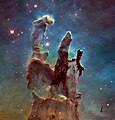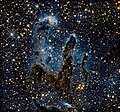Lêer:Eagle Nebula - GPN-2000-000987.jpg

Grootte van hierdie voorskou: 606 × 600 piksels. Ander resolusies: 242 × 240 piksels | 485 × 480 piksels | 776 × 768 piksels | 1 035 × 1 024 piksels | 1 944 × 1 924 piksels.
Oorspronklike lêer (1 944 × 1 924 piksels, lêergrootte: 1,18 MG, MIME-tipe: image/jpeg)
Lêergeskiedenis
Klik op die datum/tyd om te sien hoe die lêer destyds gelyk het.
| Datum/Tyd | Duimnael | Dimensies | Gebruiker | Opmerking | |
|---|---|---|---|---|---|
| huidig | 00:30, 3 Oktober 2012 |  | 1 944 × 1 924 (1,18 MG) | Ras67 | losslessly cropped with Jpegcrop |
| 01:17, 9 April 2009 |  | 1 993 × 1 973 (1,45 MG) | BotMultichillT | {{Information |Description={{en|1=These eerie, dark pillar-like structures are columns of cool interstellar hydrogen gas and dust that are also incubators for new stars. The pillars protrude from the interior wall of a dark molecular cloud like stalagmite |
Lêergebruik
Daar is geen bladsye wat dié lêer gebruik nie.
Globale lêergebruik
Die volgende ander wiki's gebruik hierdie lêer:
- Gebruik in ar.wikipedia.org
- Gebruik in arz.wikipedia.org
- Gebruik in en.wikipedia.org
- Gebruik in eu.wikipedia.org
- Gebruik in fa.wikipedia.org
- Gebruik in hu.wikipedia.org
- Gebruik in ka.wikipedia.org
- Gebruik in kw.wikipedia.org
- Gebruik in mk.wikipedia.org
- Gebruik in uk.wikipedia.org
- Gebruik in zh.wikipedia.org




